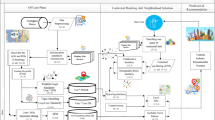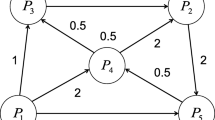Abstract
Leveraging community-contributed information such as blogs, Global Positioning System, and images that are geographically tagged for suggestions on navigation with mobile based communication is becoming a research area. The travel recommender a system is based on Points Of Interests (POIs) of user’s emerge in many studies and enterprise applications. Most of the preceeding travel recommendation methodologies are capable of recommending a personalized travel by considering the POIs. The major objective of this paper is to design a new Multi-Ontology based Points of Interest (MO-POIs) travel recommendation system which considers the POIs of the user along with the individual semantic information. Initially stage, the personalized MO-POIs sequence is recommended, and the routes are ranked based on the individual depending on the package he uses. Both the user and route package similarities are evaluated using parallel fuzzy clustering algorithm in this research work. Map Reduce is used as a parallel computation model in this research which performs computation with the help of a couple of functions that are termed as map and reduce. The social users travel records are used to optimize the top ranked routes. Finally, the new MO-POIs recommendation system evaluation is finished with a billion of Flicker images, uploaded by thousands of users and also more than 24,000 travelogues that cover the estimated 850 and above travel POIs in nine renowned cities, and illustrates its efficiency. The results are measured using the performance metrics like average precision and weighted average precision. The evaluation concludes that the proposed algorithm is capable of performing well in recent works that uses travel logs.





Similar content being viewed by others
References
Sui, D., & Goodchild, M. (2011). The convergence of GIS and social media: Challenges for GIScience. International Journal of Geographical Information Science, 25(11), 1737–1748.
Luo, J., Joshi, D., Yu, J., & Gallagher, A. (2011). Geotagging in multimedia and computer vision—A survey. Multimedia Tools and Applications, 51(1), 187–211.
Ahern, S., et al. (2007). World explorer: Visualizing aggregate data from unstructured text in georeferenced collections. In Proceedings of the 7th ACM/IEEE-CS joint conference on digital libraries 2007 (JCDL’07) (pp. 1–10).
Serdyukov, P., Murdock, V., & Van Zwol, R. (2009). Placing flicker photos on a map. In Proceedings of the 32nd international ACM SIGIR conference on research and development in information retrieval (pp. 484–491).
Yang, Y., & Gong, Z. (2011). Identifying points of interest by self-tuning clustering. In Proceedings of the 34th international ACM SIGIR conference on research and development in information retrieval (pp. 883–892).
Lu, X., Wang, C., Yang, J. M., Pang, Y., & Zhang, L. (2010). Photo2trip: Generating travel routes from geo-tagged photos for trip planning. In Proceedings of the 18th ACM international conference on multimedia (pp. 143–152).
Yin, Z., Cao, L., Han, J., Luo, J., & Huang, T. (2011). Diversified trajectory pattern ranking in geo-tagged social media. In Proceedings of the 2011 Society for Industrial and Applied Mathematics (SIAM) international conference on data mining (pp. 980–991).
Naaman, M. (2011). Geographic information from georeferenced social media data. SIGSPATIAL Special, 3(2), 54–61.
Sang, J., Mei, T., Sun, J. T., Xu, C., & Li, S. (2012). Probabilistic sequential POIs recommendation via check-in data. In Proceedings of the 20th international conference on advances in geographic information systems (pp. 402–405).
Liu, Q., Chen, E., Xiong, H., Ding, C. H., & Chen, J. (2012). Enhancing collaborative filtering by user interest expansion via personalized ranking. IEEE Transactions on Systems, Man, and Cybernetics, Part B (Cybernetics), 42(1), 218–233.
Shi, Y., Serdyukov, P., Hanjalic, A., & Larson, M. (2011). Personalized landmark recommendation based on geo-tags from photo sharing sites. International Conference on Weblogs and Social Media (ICWSM), 11, 622–625.
Wei, L. Y., Zheng, Y., & Peng, W. C. (2012). Constructing popular routes from uncertain trajectories. In Proceedings of the 18th ACM SIGKDD international conference on knowledge discovery and data mining (pp. 195–203).
Kurashima, T., Iwata, T., Irie, G., & Fujimura, K. (2010). Travel route recommendation using geotags in photo sharing sites. In Proceedings of the 19th ACM international conference on information and knowledge management (pp. 579–588).
Qian, X., Feng, H., Zhao, G., & Mei, T. (2014). Personalized recommendation combining user interest and social circle. IEEE Transactions on Knowledge and Data Engineering, 26(7), 1763–1777.
Lu, X., Wang, C., Yang, J. M., Pang, Y., & Zhang, L. (2010). Photo2trip: Generating travel routes from geo-tagged photos for trip planning. In Proceedings of the 18th ACM international conference on multimedia (pp. 143–152).
Kori, H., Hattori, S., Tezuka, T., & Tanaka, K. (2007). Automatic generation of multimedia tour guide from local blogs. In International conference on multimedia modeling (pp. 690–699). Berlin: Springer.
Yuan, Q., Cong, G., & Sun, A. (2014). Graph-based point-of-interest recommendation with geographical and temporal influences. In Proceedings of the 23rd ACM international conference on conference on information and knowledge management (pp. 659–668).
Zheng, Y., Zhang, L., Xie, X., & Ma, W. Y. (2009). Mining interesting locations and travel sequences from GPS trajectories. In Proceedings of the 18th international conference on World Wide Web (pp. 791–800).
Wachowicz, M., Ong, R., Renso, C., & Nanni, M. (2011). Finding moving flock patterns among pedestrians through collective coherence. International Journal of Geographical Information Science, 25(11), 1849–1864.
Clements, M., Serdyukov, P., De Vries, A. P., & Reinders, M. J. (2010). Usingflickrgeotags to predict user travel behaviour. In Proceedings of the 33rd international ACM SIGIR conference on research and development in information retrieval (pp. 851–852).
Majid, A., Chen, L., Chen, G., Mirza, H. T., Hussain, I., & Woodward, J. (2013). A context-aware personalized travel recommendation system based on geotagged social media data mining. International Journal of Geographical Information Science, 27(4), 662–684.
Lou, P., Zhao, G., Qian, X., Wang, H., & Hou, X. (2016). Schedule a rich sentimental travel via sentimental poi mining and recommendation. In Proceedings of the 20th ACM international conference on multimedia big data.
Ge, Y., Liu, Q., Xiong, H., Tuzhilin, A., & Chen, J. (2011). Cost-aware travel tour recommendation. In Proceedings of the 17th ACM SIGKDD international conference on knowledge discovery and data mining (pp. 983–991).
Wang, X., Yu, M., Zhang, L., Cai, R., & Ma, W. (2009). Argo: intelligent advertising by mining a user’s interest from his photo collections. In Proceedings of the third international workshop on data mining and audience intelligence for advertising (pp. 18–26). ACM.
Clements, M., Serdyukov, P., de Vries, A., & Reinders, M. (2011). Personalized travel recommendation based on location co-occurrence. arXiv preprint arXiv:1106.5213.
Hao, Q., Cai, R., Wang, C., Xiao, R., Yang, J., Pang, Y., et al. (2010). Equip tourists with knowledge mined from travelogues. In Proceedings of the 19th international conference on World Wide Web (pp. 401–410). ACM.
Hao, Q., Cai, R., Wang, X., Yang, J., Pang, Y., & Zhang, L. (2009). Generating location overviews with images and tags by mining user-generated travelogues. In Proceedings of the 17th ACM international conference on multimedia (pp. 801–804). ACM.
Jiang, S., Qian, X., Shen, J., Fu, Y., & Mei, T. (2015). Author topic model based collaborative filtering for personalized POI recommendation. IEEE Transactions on Multimedia, 17(6), 907–918.
Ding, C., Li, T., & Peng, W. (2008). On the equivalence between non-negative matrix factorization and probabilistic latent semantic indexing. Computational Statistics & Data Analysis, 52(8), 3913–3927.
Jiang, S., Qian, X., Mei, T., & Fu, Y. (2016). Personalized travel sequence recommendation on multi-source big social media. IEEE Transactions on Big Data, 2(1), 43–56.
Mendonça, F., Coelho, K., de Andrade, A. Q., & Almeida, M. B. (2012). Knowledge acquisition in the construction of ontologies: a case study in the domain of hematology. In ICBO (pp. 1–5).
Abecker, A., & van Elst, L. (2009). Ontologies for knowledge management. In S. Staab & R. Studer (Eds.), Handbook on ontologies (pp. 713–734). Berlin: Springer.
Kettunen, P., & Sarjakoski, L. T. (2015). Empirical construction of a landmark ontology for wayfinding in varying conditions of nature. In Proceedings of the 18th AGILE International Conference on Geographic Information Science-Geographic Information Science as an Enabler of Smarter Cities and Communities. CD-ROM.
Noy, N. F., & McGuinness D. L. (2001). Ontology development 101: A guide to creating your first ontology. ftp://ftp.ksl.stanford.edu/pub/KSL_Reports/KSL-01-05.pdf.gz.
W3C. (2013). Semantic Web. http://www.w3.org/standards/semanticweb.
Sidorov, G., Gelbukh, A., Gómez-Adorno, H., & Pinto, D. (2014). Soft similarity and soft cosine measure: Similarity of features in vector space model. Computación y Sistemas, 18(3), 491–504.
Krestel, R., Fankhauser, P., & Nejdl, W. (2009). Latent Dirichlet allocation for tag recommendation. In Proceedings of the third ACM conference on recommender systems (pp. 61–68).
Chothani, N. G., Patel, D. D., & Mistry, K. D. (2017). Support vector machine based classification of current transformer saturation phenomenon. Journal of Green Engineering, 7(1), 25–42.
Kumar, K. P., & Venkateshwarlu, S. (2017). A neuro-fuzzy controlled solar photovoltaic and PHEV based frequency regulation in a microgrid without storage system. Journal of Green Engineering, 7(1), 311–332.
Author information
Authors and Affiliations
Corresponding author
Rights and permissions
About this article
Cite this article
Suresh Kumar, N., Thangamani, M. Multi-Ontology Based Points of Interests (MO-POIS) and Parallel Fuzzy Clustering (PFC) Algorithm for Travel Sequence Recommendation with Mobile Communication on Big Social Media. Wireless Pers Commun 103, 991–1010 (2018). https://doi.org/10.1007/s11277-018-5492-0
Published:
Issue Date:
DOI: https://doi.org/10.1007/s11277-018-5492-0




